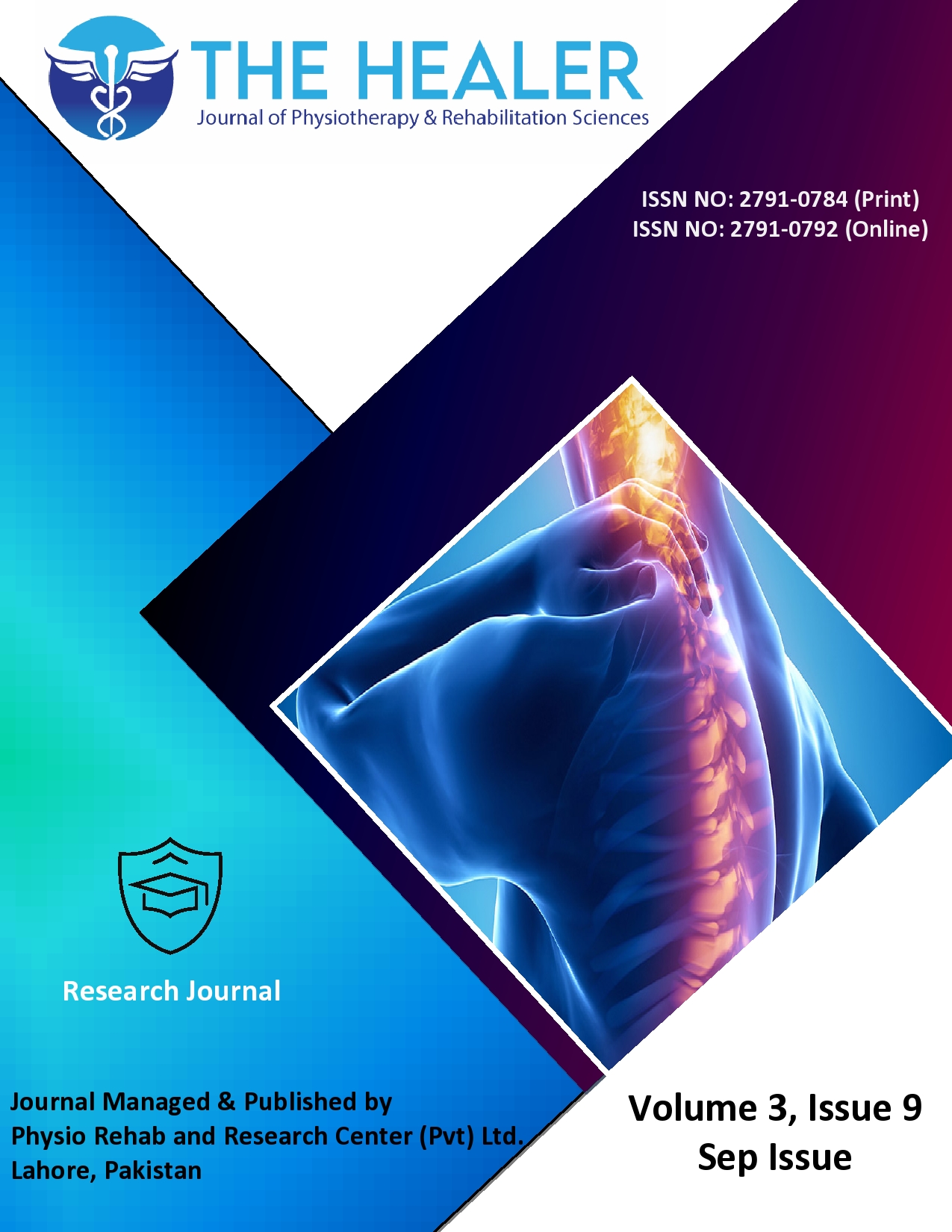Frequency of Diastasis Recti Abdominis in Pregnant Women of Third Trimester
Diastasis Recti in Women of Third Trimester
DOI:
https://doi.org/10.55735/hjprs.v3i9.205Keywords:
diastasis recti abdominis, frequency, pregnant, third trimesterAbstract
Background: Diastasis of recti abdominis has been defined as the separation of the bundles of muscles that are present lateral to the linea alba. It has been observed during pregnancy, postpartum and even in postmenopausal women. Literature shows us that a lot of work has been conducted on this subject in Western countries but Pakistan lacks this kind of authentic literature. Objective: This study aims to determine the frequency of Diastasis recti abdominis in pregnant women in their third trimester. Methods: This is an observational cross-sectional study. The sample of this study was n=169. Pregnant females in their third trimester with diastasis recti abdominis were recruited in this study. The finger width method was used to test the presence of diastasis recti abdominis. The data for this study was collected from the obstetric department of Jinnah, Fatima Memorial, General and Itifaq Hospitals, Lahore, Pakistan. A purposive sampling technique was used to recruit participants in this study. Data was analyzed using Statistical Package for Social Sciences 23. The quantitative variables were represented as mean and standard deviation. An alpha level of 0.05 was chosen as a significant level. Results: 52 pregnant females in their third trimester out of 169 were diagnosed with diastasis recti abdominis. The width of their muscle separation was recorded to be greater than 2 cm. The range of age for the recruited pregnant females in their third trimester was 18 years to 40 years. 110 pregnant females out of 169 were in the age range of 24 years to 32 years. It was also observed that not all the pregnant females recruited in this study had diastasis recti abdominis but 48.5% of the participants had lower back pain which was confirmed by finger width test. Conclusion: This study concludes that the frequency of diastasis recti abdominis in pregnant females in their third trimester is 30.8%. This study also concludes that Diastasis recti abdominis was common in pregnant females of age greater than 30 years. This study concludes that diastasis recti abdominis was more common in pregnant females who were not engaged in any sort of regular exercise.
References
Alamer A, Kahsay G, Ravichandran H. Prevalence of diastasis recti and associated factors among women attending antenatal and postnatal careatmekelle city health facilities, tigray, ethiopia. Age 2019; 20: 37. https://doi.org/10.1590/S1413-35552009005000037
Cavalli M, Aiolfi A, Bruni P, et al. Prevalence and risk factors for diastasis recti abdominis: a review and proposal of a new anatomical variation. Hernia 2021; 25(4): 883-90. https://doi.org/10.1007/s10029-021-02468-8
Kaufmann R, Reiner C, Dietz U, Clavien P, Vonlanthen R, Käser S. Normal width of the linea alba, prevalence, and risk factors for diastasis recti abdominis in adults, a cross-sectional study. Hernia 2022: 1-10. DOI : https://doi.org/10.1007/s10029-021-02493-7
Da Mota PGF, Pascoal AGBA, Carita AIAD, Bø K. Prevalence and risk factors of diastasis recti abdominis from late pregnancy to 6 months postpartum, and relationship with lumbo-pelvic pain. Manual therapy 2015; 20(1): 200-5. https://doi.org/10.1016/j.math.2014.09.002
Thabet AA, Alshehri MA. Efficacy of deep core stability exercise program in postpartum women with diastasis recti abdominis: a randomised controlled trial. Journal of musculoskeletal & neuronal interactions 2019; 19(1): 62. https://www.ncbi.nlm.nih.gov/pmc/articles/PMC6454249/
Gluppe S, Engh ME, Kari B. Women with diastasis recti abdominis might have weaker abdominal muscles and more abdominal pain, but no higher prevalence of pelvic floor disorders, low back and pelvic girdle pain than women without diastasis recti abdominis. Physiotherapy 2021; 111: 57-65. https://doi.org/10.1016/j.physio.2021.01.008
Chiarello CM, Falzone LA, McCaslin KE, Patel MN, Ulery KR. The effects of an exercise program on diastasis recti abdominis in pregnant women. Journal of women’s health physical therapy 2005; 29(1): 11-6. https://journals.lww.com/jwhpt/Fulltext/2005/29010/The_Effects_of_an_Exercise_Program_on_Diastasis.3.aspx?bid=AMCampaignWKHJ
Wang Q, Yu X, Chen G, Sun X, Wang J. Does diastasis recti abdominis weaken pelvic floor function? A cross-sectional study. International Urogynecology Journal 2020; 31: 277-83. DOI : https://doi.org/10.1007/s00192-019-04005-9
Roehling TL. Are Finger Width Palpation, Tape Measure, and Caliper Reliable, Valid, and Accurate to Diagnose Diastasis Recti Abdominis (DRA)? : Nova Southeastern University; 2020.
Keeler J, Albrecht M, Eberhardt L, Horn L, Donnelly C, Lowe D. Diastasis recti abdominis: a survey of women's health specialists for current physical therapy clinical practice for postpartum women. Journal of women’s health physical therapy 2012; 36(3): 131-42. https://journals.lww.com/jwhpt/Fulltext/2012/09000/Diastasis_Recti_Abdominis__A_Survey_of_Women_s.4.aspx
Mota P, Pascoal AG, Sancho F, Carita AI, Bø K. Reliability of the inter-rectus distance measured by palpation. Comparison of palpation and ultrasound measurements. Manual Therapy 2013; 18(4): 294-8. https://doi.org/10.1016/j.math.2012.10.013
Van de Water A, Benjamin D. Measurement methods to assess diastasis of the rectus abdominis muscle (DRAM): a systematic review of their measurement properties and meta-analytic reliability generalisation. Manual therapy 2016; 21: 41-53. https://doi.org/10.1016/j.math.2015.09.013
Rett M, Braga M, Bernardes N, Andrade S. Prevalence of diastasis of the rectus abdominis muscles immediately postpartum: comparison between primiparae and multiparae. Brazilian Journal of Physical Therapy 2009; 13: 275-80. https://doi.org/10.1590/S1413-35552009005000037
Parker MA, Millar LA, Dugan SA. Diastasis rectus abdominis and lumbo-pelvic pain and dysfunction-are they related? The Journal of Women's & Pelvic Health Physical Therapy 2009; 33(2):15-22. https://journals.lww.com/jwphpt/Fulltext/2009/33020/Diastasis_Rectus_Abdominis_and_Lumbo_Pelvic_Pain.3.aspx
Yaseen K, Anwar N, Ayesha S, Tauqeer S, Khalid K, Shaheen F. Prevalence of Diastasis Recti among Pregnant Women: A Cross Sectional Study. Pakistan Journal of Medical Research 2022; 61(1): 40-2. https://www.pjmr.org.pk/index.php/pjmr/article/view/221
Aabroo S, Riaz H, Saeed A, Ashraf F. Frequency of diastasis recti and lumbopelvic pain during pregnancy and factors associated with diastasis recti. Rawal Medical Journal 2020; 45(3): 682-5. https://www.rmj.org.pk/fulltext/27-1540376487.pdf
Gandhi B, Dhankar S, Desphande S, Arora SP. Impact of Diastasis Recti Abdominis and low back pain on Quality Of Life in Post-partum female. Indian J Forensic Med Toxicol 2021; 15(1): 887-9. DOI: 10.22270/jmpas.V10I4.1297
Bobowik PŻ, Dąbek A. Physiotherapy in women with diastasis of the rectus abdominis muscles. Advances in Rehabilitation 2018; 32(3): 11-7. DOI: 10.5114/areh.2018.80964

Downloads
Published
How to Cite
License
Copyright (c) 2023 The Healer Journal of Physiotherapy and Rehabilitation Sciences

This work is licensed under a Creative Commons Attribution 4.0 International License.
CC BY











